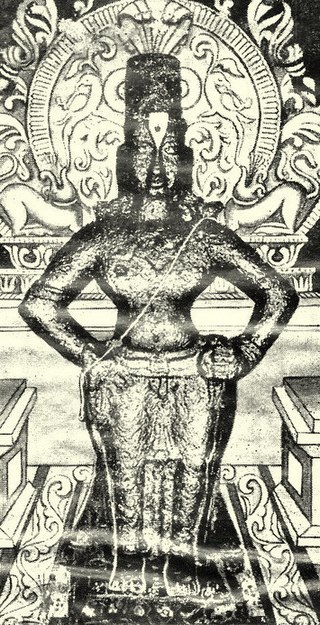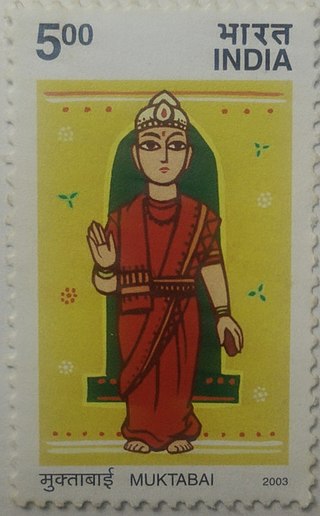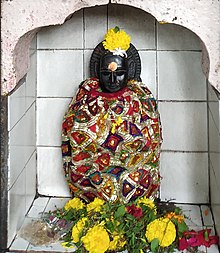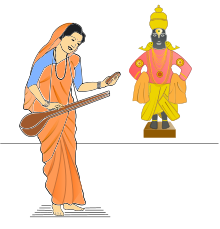
Sant Dnyaneshwar, also referred to as Dnyaneshwar, Dnyanadeva, Dnyandev or Mauli or Dnyaneshwar Vitthal Kulkarni (1275–1296), was a 13th-century Indian Marathi saint, poet, philosopher and yogi of the Nath and Varkari tradition. In his short life of 21 years, he authored Dnyaneshwari and Amrutanubhav. These are the oldest surviving literary works in the Marathi language, and considered to be milestones in Marathi literature. Sant Dnyaneshwar's ideas reflect the non-dualistic Advaita Vedanta philosophy and an emphasis on Yoga and bhakti towards Vithoba, an incarnation of Vishnu. His legacy inspired saint-poets such as Eknath and Tukaram, and he is one of the founders of the Varkari (Vithoba-Krishna) Bhakti movement tradition of Hinduism in Maharashtra. Dnyaneshwar undertook samadhi at Alandi in 1296 by entombing himself in an underground chamber.

Sant Tukaram Maharaj, also known as Tuka, Tukobaraya, Tukoba, was a Hindu, Marathi Saint of Varkari sampradaya" in Dehu village, Maharashtra in the 17th century. He was a bhakt of the god Vithoba of Pandharpur. He is best known for his devotional poetry called Abhanga, which are popular in Maharashtra, many of his poems deal with social reform.

Namdev, also transliterated as Nam Dayv, Namdeo, Namadeva, was a Marathi Vaishnava saint from Narsi, Hingoli, Maharashtra, Medieval India within the Varkari tradition of Hinduism. He was as a devotee of the deity Vithoba of Pandharpur.

Mahipati was an 18th century Marathi language hagiographer who wrote biographies of prominent Hindu Vaishnava sants who had lived between the 13th and the 17th centuries in Maharashtra and other regions of India.

Warkari is a sampradaya within the bhakti spiritual tradition of Hinduism, geographically associated with the Indian state of Maharashtra. Warkaris worship Vitthal, the presiding deity of Pandharpur, regarded as a form of Vishnu. Saints and gurus of the bhakti movement associated with the Warkaris include Dnyaneshwar, Namdev, Chokhamela, Eknath, and Tukaram all of whom are accorded the title of Sant. Recent research has suggested that the Varkaris were historically the followers of Krishna. Vittala is also another name for Krishna. Krishna is referenced as Vittala in most Bhakthi songs of Purandara Dasa and other Bhakti Saints.

Vithoba, also known as Vitthala, and Panduranga, is a Hindu deity predominantly worshipped in the Indian states of Maharashtra and Karnataka. He is a form of the Hindu deity Vishnu in his avatar: Krishna. Vithoba is often depicted as a dark young boy, standing arms akimbo on a brick, sometimes accompanied by his consort Rakhumai.

Pundalik or Pundarika is an Indian saint and a devotee of the Hindu deity Vithoba. Vithoba is a Vaishnava deity and a recincarnation of Vishnu and Krishna. Pundalik is thought to have brought Vithoba to Pandharpur, where Vithoba's main shrine stands today. Pundalik is also the historical founder of the Varkari sect, which is centered on the worship of Vithoba.

Chokhamela was a saint from Maharashtra, India in the 13th–14th century. He belonged to the Mahar caste, which was considered that time one of the low castes in India. He was born at Mehuna Raja, a village in Deulgaon Raja Taluka of Buldhana district. He lived at Mangalvedha in Maharashtra. He wrote many Abhangas. One of his known Abhangas is 'Abir Gulal Udhlit Rang". Social activist Arvind Prabhakar Kayande Started Celebrating "Chokhamela Festival" in Deulgaon Raja. He was one of the first low-caste poets in India.

Abhanga is a form of devotional poetry sung in praise of the Hindu god Vitthal, also known as Vithoba. The word "abhang" comes from a for "non-" and bhanga for "ending" or "interrupting", in other words, a flawless, continuous process, in this case referring to a poem. By contrast, the devotional songs known as Bhajans focus on the inward journey. Abhangs are more exuberant expressions of the communitarian experience. Abhanga is considered a form of the ovi. Abhangs are sung during pilgrimage to the temples of Pandharpur, by the devotees.

Sena Nhavi, also known as Saint Sena, and Sena, is a Hindu saint-poet (sant-kavi) of the Varkari sect dedicated to the god Vithoba.
Visoba Khechara, spelled also as Visoba Khechar or Visoba Khecar, was the yogi-guru of the Varkari poet-saint Namdev (c.1270-1350) of Maharashtra, India. Visoba was a disciple of the Varkari poet-saint Jñāneśvar. He had linkages with the Varkari tradition as well as the Nath tradition of Maharashtra. Though a staunch Shaiva, Visoba has composed verses in praise of the god Vithoba, the patron deity of the Varkari faith. He has also composed a metaphysical treatise called the Shatsthala.
Bahinabai or Bahina or Bahini was a female Varkari saint from Maharashtra, India. She is considered a disciple of the Varkari poet-saint Tukaram. Having been born in a Brahmin family, Bahinabai was married to a widower at a young age and spent most of her childhood wandering around Maharashtra along with her family. She describes, in her autobiography Atmamanivedana, her spiritual experiences with a calf and visions of the Varkari's patron deity Vithoba and Tukaram. She reports being subjected to verbal and physical abuse by her husband, who despised her spiritual inclination but who finally accepted her chosen path of devotion (bhakti). Unlike most female-saints who never married or renounced their married life for God, Bahinabai remained married her entire life.
Bir Kuar or Birkuar, also known as Birnath, is a Hindu god worshipped by Yadavs of western Bihar in India. He is considered to be a form of god Krishna and was born in Krishnaut clan of Ahir. He is worshipped in form of wooden posts that depict him standing arms-akimbo. Bir Kuar is honoured as the protector of cattle.

Muktabai or Mukta was a saint in the Varkari Movement. She was born in a Deshastha Brahmin family and was the younger sister of Dnyaneshwar, the first Varkari saint. She wrote forty-one abhangs throughout her life.
Maha Bhakta vijaya is a Marathi text by Mahipati around 1762 that extols the deeds of the saint-poets of the Varkari sect of Hinduism. It has been translated into various languages in India and is widely read. It forms an important part of the prayer for devotees of Vithoba at Pandharpur. An English translation was published under the provisions of the will of Justin E. Abbott in 1933.
Bhanudasa (1448–1513), was a Hindu sant who brought back the sacred image of the god Vithoba back from Vijayanagara to Pandharpur, its original location. He was Eknath’s great grandfather. As a boy he worshipped the Sun but later came to worship Vithoba. He is the subject of two chapters in the Bhaktavijaya. His Samadhi situated in solkhambi mandap of Vitthal temple at Pandharpur.
Narahari Sonar or Narharidas was a 13th-century Hindu poet-saint of the Varkari sect and goldsmith (sonar) from Maharashtra, India. His hagiography speaks about his transition from a staunch Shaiva to a Vithoba-worshipping Varkari after a miracle that makes him realize that Vithoba and Shiva are one and the same.
Ovee, also spelled owi or owee, is a poetic metre used in Marathi poems for "rhythmic prose", generally used in narrative poems. A poem using this metre is also called an ovee. Ovee is one of the "oldest Marathi song genres still performed today". It has been in use since the 13th century in written poetry; however, oral traditions of women's ovee pre-date the literary ovee. While literary ovee is used by the Varkari saints in bhakti (devotional) literature, women's ovee is passed via the oral tradition through generations of women, who sing them while working or for pleasure.
Damaji, also known as Damaji Pant, Sant Damaji and Bhakta Damaji, was a 15th-century Marathi saint (sant) or bhakta ("devotee"), venerated by the Varkari sect of Hinduism. He was the Kamavisdar of Mangalvedha under the Bahamani king of Bidar. He is described as a devotee of the god Vithoba - the patron deity of the Varkari sect. He distributed grain from the royal granaries to the people in famine. Vithoba is said to have come as an outcaste with a bag of gold to pay for the grain and rescue Damaji. The famine of 1460 is known as Damaji Pant's famine in the Deccan region in honour of Damaji's generosity in the famine.

Pandharpur Wari or Wari is a yatra to Pandharpur, Maharashtra, to honor Vithoba. It involves carrying the paduka of a saint in a palkhi, most notably of Dnyaneshwar and Tukaram, from their respective shrines to Pandharpur. Many pilgrims join this procession on foot. Warkari is a Marathi term which means "one who performs the wari". The tradition is more than 700 to 800 years old.















